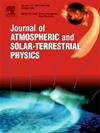Impact of atmospheric aerosols on air quality of three most polluted cities of Uttar Pradesh, India
IF 1.9
4区 地球科学
Q3 GEOCHEMISTRY & GEOPHYSICS
Journal of Atmospheric and Solar-Terrestrial Physics
Pub Date : 2025-04-15
DOI:10.1016/j.jastp.2025.106516
引用次数: 0
Abstract
In recent decades, atmospheric aerosol/particulate matter has emerged as a central theme of increasing levels of air pollution around the world, especially developing nations like India. As per World Air Quality Report 2022, 14 of the 50 most polluted cities around the globe are from Uttar Pradesh, India. The availability of data on air quality in the most polluted cities of Uttar Pradesh is not much clear. Therefore, in the present study the data about air pollutants and meteorological parameters from Lucknow, Varanasi and Prayagraj for the year 2023 have been taken from the portal of the Central Pollution Control Board and analyzed. The outcomes show that monthly and annual concentrations of PM10 & PM2.5 were found to be higher in Lucknow and lowest concentrations in Varanasi during the study period. Among the all-selected cities, the highest AQI value has been noticed in Poor category (>250) in Lucknow and lowest for Good class (<50) in Varanasi. The poor category of AQI has well known for prompting serious health effects on humans and proficient of causing serious respiratory, lung and heart illnesses. The highest wind speed, vertical wind speed, temperature and lowest humidity are conductive to dispersion of atmospheric pollutants in Varanasi and the lowest wind speed and temperature and higher humidity are not conductive to vertical and horizontal diffusion of air pollutants, resulting in higher concentrations of atmospheric aerosols/particulate pollution was observed in Lucknow. Consequential, this study revealed that meteorological parameters have a tremendous role in the accumulation and dispersion of atmospheric pollutants. In addition, this study also suggests that due to long-term restrictions on anthropogenic activities in 2020 and the implementation of the National Clean Air Programme in 2019 may have also led to significant improvement in air quality in Varanasi and Prayagraj. However, due to the increasing pace of anthropogenic activities (urbanization, construction activities, industrialization and vehicular sources) has significantly deteriorated the air quality in Lucknow city. The overall outcome of quantifying interactions between meteorological conditions and aerosol/PM concentration will play an important role for future researchers to understand the variability of aerosol/PM and seek ways to minimize air pollution in all the selected cities.
大气气溶胶对印度北方邦三个污染最严重城市空气质量的影响
近几十年来,大气气溶胶/颗粒物已经成为世界各地空气污染水平不断上升的一个中心主题,尤其是像印度这样的发展中国家。根据《2022年世界空气质量报告》,全球50个污染最严重的城市中有14个来自印度北方邦。关于北方邦污染最严重城市的空气质量数据的可用性并不十分清楚。因此,在本研究中,从中央污染控制委员会的门户网站上获取了2023年勒克瑙、瓦拉纳西和Prayagraj的空气污染物和气象参数数据并进行了分析。结果表明,PM10的月浓度和年浓度与大气中pm2.5的浓度基本一致。在研究期间,勒克瑙的PM2.5浓度最高,瓦拉纳西的浓度最低。在所有选定的城市中,最差的城市是勒克瑙(>250),最差的是瓦拉纳西(<50)。众所周知,空气质量差的类别会对人体健康造成严重影响,并可能导致严重的呼吸、肺部和心脏疾病。瓦拉纳西的最高风速、垂直风速、温度和最低湿度有利于大气污染物的扩散,而最低风速、温度和较高湿度不利于空气污染物的垂直和水平扩散,导致勒克瑙的大气气溶胶/颗粒物污染浓度较高。结果表明,气象参数对大气污染物的积累和扩散具有重要作用。此外,该研究还表明,由于2020年对人为活动的长期限制以及2019年国家清洁空气计划的实施,也可能导致瓦拉纳西和Prayagraj的空气质量显着改善。然而,由于人为活动(城市化、建筑活动、工业化和车辆源)的步伐加快,勒克瑙市的空气质量显著恶化。量化气象条件与气溶胶/PM浓度之间相互作用的总体结果将对未来研究人员了解气溶胶/PM的变异性并寻求减少所有选定城市空气污染的方法发挥重要作用。
本文章由计算机程序翻译,如有差异,请以英文原文为准。
求助全文
约1分钟内获得全文
求助全文
来源期刊

Journal of Atmospheric and Solar-Terrestrial Physics
地学-地球化学与地球物理
CiteScore
4.10
自引率
5.30%
发文量
95
审稿时长
6 months
期刊介绍:
The Journal of Atmospheric and Solar-Terrestrial Physics (JASTP) is an international journal concerned with the inter-disciplinary science of the Earth''s atmospheric and space environment, especially the highly varied and highly variable physical phenomena that occur in this natural laboratory and the processes that couple them.
The journal covers the physical processes operating in the troposphere, stratosphere, mesosphere, thermosphere, ionosphere, magnetosphere, the Sun, interplanetary medium, and heliosphere. Phenomena occurring in other "spheres", solar influences on climate, and supporting laboratory measurements are also considered. The journal deals especially with the coupling between the different regions.
Solar flares, coronal mass ejections, and other energetic events on the Sun create interesting and important perturbations in the near-Earth space environment. The physics of such "space weather" is central to the Journal of Atmospheric and Solar-Terrestrial Physics and the journal welcomes papers that lead in the direction of a predictive understanding of the coupled system. Regarding the upper atmosphere, the subjects of aeronomy, geomagnetism and geoelectricity, auroral phenomena, radio wave propagation, and plasma instabilities, are examples within the broad field of solar-terrestrial physics which emphasise the energy exchange between the solar wind, the magnetospheric and ionospheric plasmas, and the neutral gas. In the lower atmosphere, topics covered range from mesoscale to global scale dynamics, to atmospheric electricity, lightning and its effects, and to anthropogenic changes.
 求助内容:
求助内容: 应助结果提醒方式:
应助结果提醒方式:


